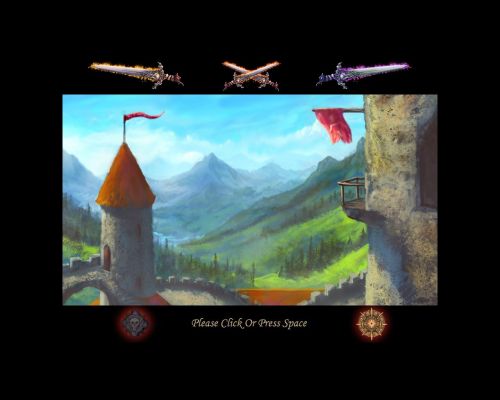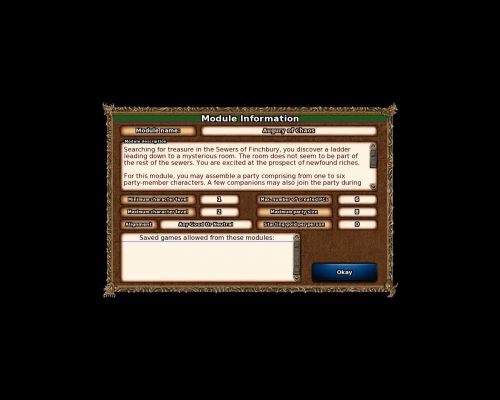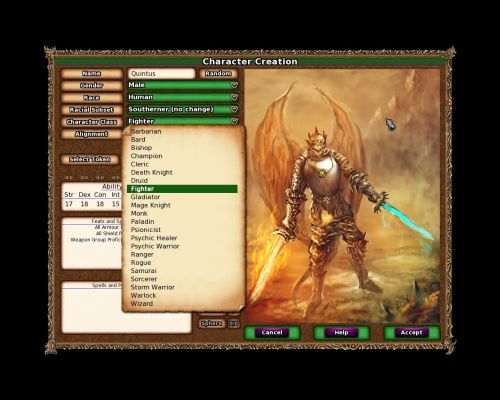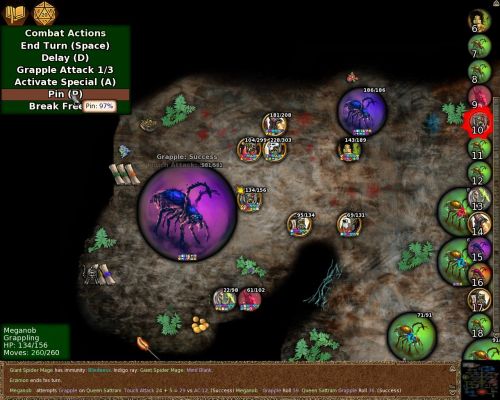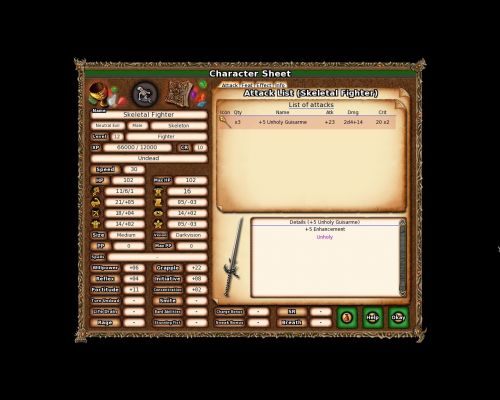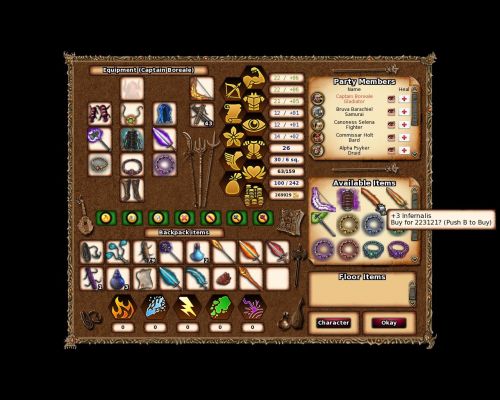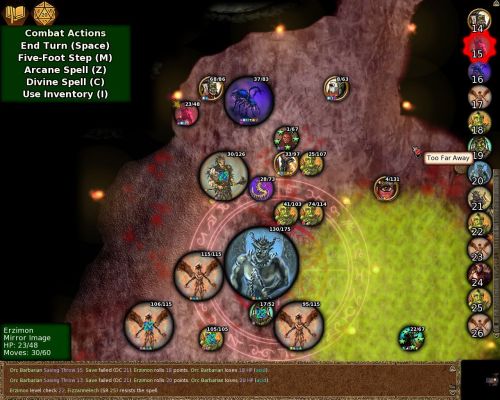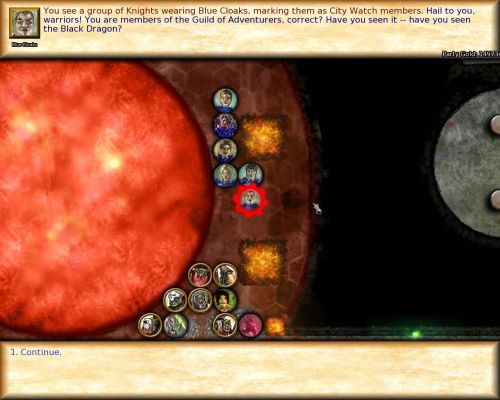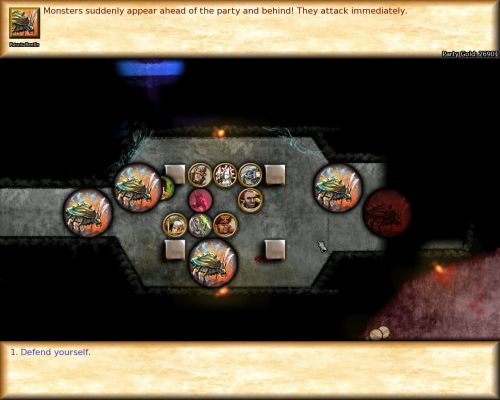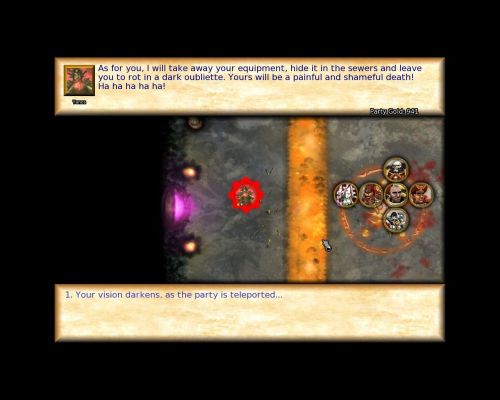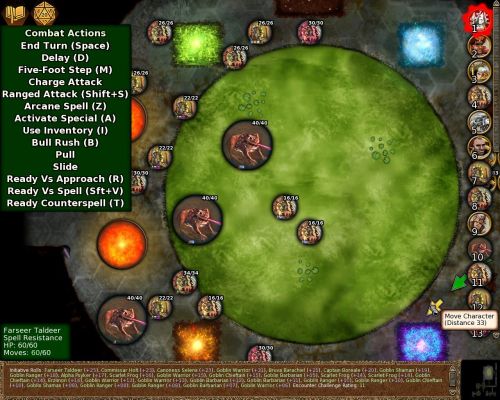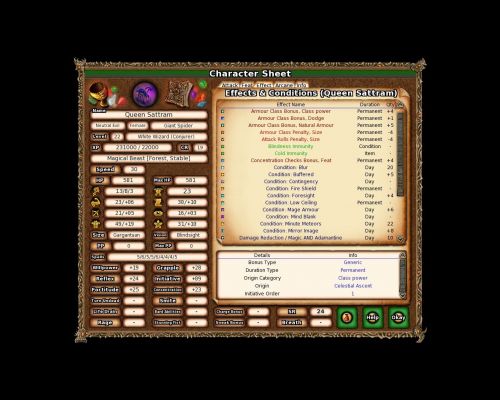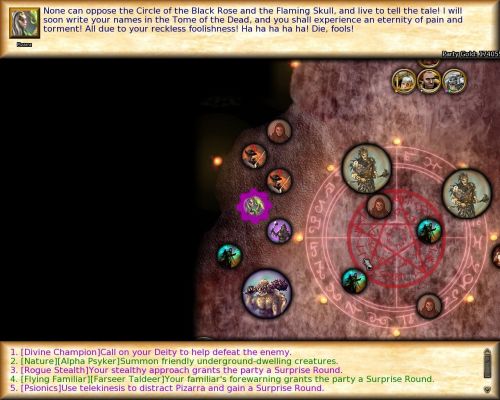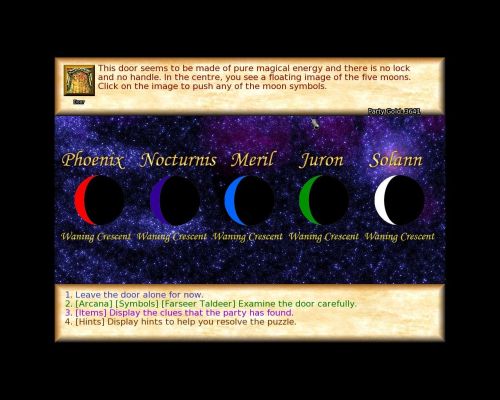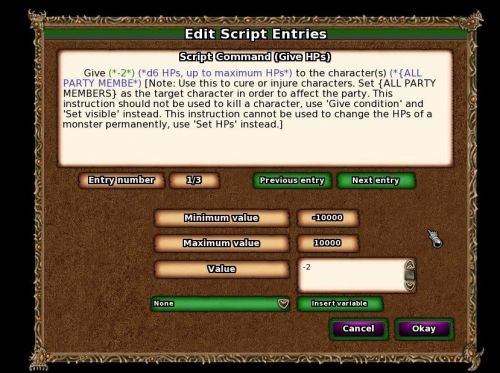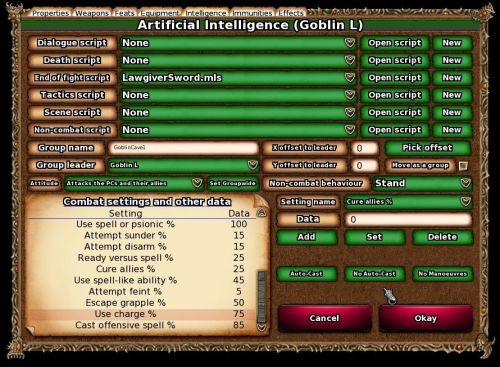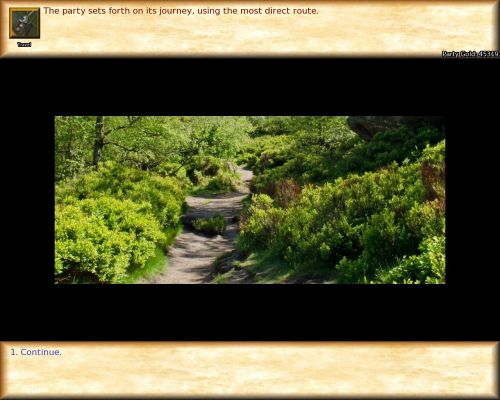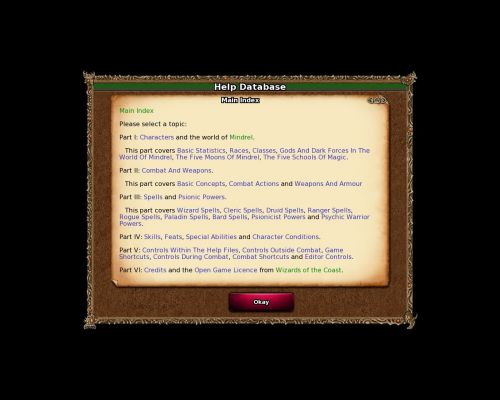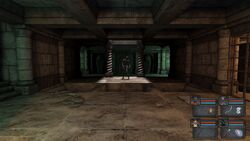RPG Codex Preview: Knights of the Chalice 2 - Augury of Chaos
RPG Codex Preview: Knights of the Chalice 2 - Augury of Chaos
Codex Preview - posted by Infinitron on Thu 10 December 2020, 19:15:51
Tags: Heroic Fantasy Games; Knights of the Chalice 2Released in 2009 by eccentric Frenchman Pierre Begue, the original Knights of the Chalice was one of the Codex's first indie favorites. It achieved that status not merely because it was a rare turn-based RPG in an age of consolized cinematic popamole, but because it was genuinely well-designed. During most of its decade-long development, the biggest concern about Knights of the Chalice 2 was that its abstract, tabletop-like visual style lacked appeal. But surely whatever the game sacrificed in looks would be compensated with even better gameplay. Well, that's not how things turned out. Since its release in July, the inaugural Augury of Chaos module for Knights of the Chalice 2 has become notorious for its outlandishly high difficulty level and generally poor balance, issues which subsequent patches appear to have only scratched the surface of. Today our very own Darth Roxor is here to tell you all about it. As an added bonus, we also have some details about the game's module editor from the esteemed Dorateen. Here's an excerpt from the review:
Read the full article: RPG Codex Review: Knights of the Chalice 2 - Augury of Chaos
The bullshit in this game’s encounter design is all-encompassing and ever-present. I already mentioned the enemy equipment. Now consider that you are always outnumbered and out-levelled, often even very significantly. Then you have the monster spawns out of nowhere, which can include cannon fodder as much as horrible abominations of terrible doom. Then there are the hundred million billion weird-ass abilities like breath weapons, death explosions, arbitrary critical hit immunities (hello, evil cultist fighters) and “spell-like abilities” that everyone packs in large numbers and which are all nothing but bullshit – bonus points if they are spells from spellbooks unavailable to a given caster class, and which just so happen to benefit the owner’s loadout and traits. Of course, there are also plenty of “surprise” encounters where you can’t even avoid the surprise because, to quote, “suddenly enemies appear all around you.”
But that is not all. One of the more insulting aspects of this game and its encounters are the enemy casters. For starters, they always know all the spells that are available at their level, so most of them act in the exact same way (unless scripted to do something specific on their first turn), and they are always ready for everything you can throw at them thanks to this. For reasons more than one, too, because they also always come pre-buffed with every single buff spell there is, even if they materialise out of nowhere. And believe me, the end-game becomes absolute nightmare fuel because of this. In the final chapter, every encounter has at least 4 supercharged mages, sometimes even more, sometimes it even keeps spawning more, all of them are pre-buffed to the point of stupidity, and if you don’t manage to somehow shut them down immediately, you just get nuked to oblivion.
What has to be said about the above is that this is not even particularly “difficult.” It's just depressing. The way all those enemy mages come pre-buffed with a mix of blur, mirror image, mind blank, foresight, good fortune, dispelling buffer, stoneskin and contingent break enchantment is depressing. The way they all know ALL the spells their class has to offer is depressing. The way they just keep spawning new ones is depressing. The way they always open up with accelerated spell into double instakill nuke cast is depressing. Their up-the-ass spell resistance is depressing. The fact they stand on freaking towers and can’t be reached by melee characters is depressing.
It’s like peeling a gigantic rotten onion. You keep stripping the layers one by one, you cry all the way through, your fingers stink, and ultimately it doesn’t do you any good. This is simply not how you make RPG encounters. Though fortunately, it has to be stressed that this madness is nearly exclusive to the endgame. Prior to chapter 4, the enemy casters are not yet high level enough to have access to all those spells, and they aren’t as numerous and omni-present in every fight.
Still, if only the nonsense were contained to the casters. Some of the fights in this game are just beyond the pale when it comes to the numbers, levels and types of enemies thrown against you, as well as the “battlefield conditions.” There’s a sequence of fights that first disables all the magical effects on your equipment. Your reward for defeating the boss in chapter 1 is getting stripped of all your stuff. The final fight has a “damage each turn” effect, which Pierre clearly wasn’t able to implement as a regular “environmental hazard,” so it’s instead a bunch of invisible fire tiles all over the place – which means you can’t use area spells like grease and quicksand and every single enemy (including mummies) is fire immune to mask this… and that’s STILL not all.
The worst thing still is that after some point, Augury of Chaos turns into a quick draw contest. Either you win initiative and can obliterate the enemy first (or at least shut down his most important characters), or you get blown up to hell. You will start noticing this around the middle of chapter 3, and the final chapter 4 has that in every single encounter, and I’m not exaggerating. If there is even a single mage who gets to act before you, he will open with a double cast of Prismatic Void (a cute mass-AoE version of Prismatic Spray, courtesy of Pierre’s unhinged homebrew experiments), and remove at least 75% of your party from the game.
Honestly, the campaign feels like Pierre thought that since everyone liked the optional final battle in KotC1 so much, every single battle here ought to be like that too. It’s a neverending slaughterfest established by a sadistic gamemaster, who would have otherwise been quickly abandoned by his players in a real life situation. If you watched the cartoon Dexter’s Laboratory, you might remember the D&D spoof episode, where Dexter keeps fudging the dice against the players and throwing increasingly impossible odds at them. Augury of Chaos gives you the same experience. Eventually, one of your sole motivations for pushing on will be this morbid curiosity what kind of sadistic punishment the deranged gamemaster prepared for you around the next corner. Because beating those ridiculously overpowered encounters often isn't even satisfying when your only reward is just more forceful violation to come, without even as much as a broken penny in return.
And the funniest thing about this? I can bet my right butt cheek that Pierre never played through the campaign in a legit way, from start to finish, to test how it plays. You can tell by the Kickstarter gameplay preview videos, where he fails to beat each and every single encounter presented. This game was simply designed in a vacuum.
But that is not all. One of the more insulting aspects of this game and its encounters are the enemy casters. For starters, they always know all the spells that are available at their level, so most of them act in the exact same way (unless scripted to do something specific on their first turn), and they are always ready for everything you can throw at them thanks to this. For reasons more than one, too, because they also always come pre-buffed with every single buff spell there is, even if they materialise out of nowhere. And believe me, the end-game becomes absolute nightmare fuel because of this. In the final chapter, every encounter has at least 4 supercharged mages, sometimes even more, sometimes it even keeps spawning more, all of them are pre-buffed to the point of stupidity, and if you don’t manage to somehow shut them down immediately, you just get nuked to oblivion.
What has to be said about the above is that this is not even particularly “difficult.” It's just depressing. The way all those enemy mages come pre-buffed with a mix of blur, mirror image, mind blank, foresight, good fortune, dispelling buffer, stoneskin and contingent break enchantment is depressing. The way they all know ALL the spells their class has to offer is depressing. The way they just keep spawning new ones is depressing. The way they always open up with accelerated spell into double instakill nuke cast is depressing. Their up-the-ass spell resistance is depressing. The fact they stand on freaking towers and can’t be reached by melee characters is depressing.
It’s like peeling a gigantic rotten onion. You keep stripping the layers one by one, you cry all the way through, your fingers stink, and ultimately it doesn’t do you any good. This is simply not how you make RPG encounters. Though fortunately, it has to be stressed that this madness is nearly exclusive to the endgame. Prior to chapter 4, the enemy casters are not yet high level enough to have access to all those spells, and they aren’t as numerous and omni-present in every fight.
Still, if only the nonsense were contained to the casters. Some of the fights in this game are just beyond the pale when it comes to the numbers, levels and types of enemies thrown against you, as well as the “battlefield conditions.” There’s a sequence of fights that first disables all the magical effects on your equipment. Your reward for defeating the boss in chapter 1 is getting stripped of all your stuff. The final fight has a “damage each turn” effect, which Pierre clearly wasn’t able to implement as a regular “environmental hazard,” so it’s instead a bunch of invisible fire tiles all over the place – which means you can’t use area spells like grease and quicksand and every single enemy (including mummies) is fire immune to mask this… and that’s STILL not all.
The worst thing still is that after some point, Augury of Chaos turns into a quick draw contest. Either you win initiative and can obliterate the enemy first (or at least shut down his most important characters), or you get blown up to hell. You will start noticing this around the middle of chapter 3, and the final chapter 4 has that in every single encounter, and I’m not exaggerating. If there is even a single mage who gets to act before you, he will open with a double cast of Prismatic Void (a cute mass-AoE version of Prismatic Spray, courtesy of Pierre’s unhinged homebrew experiments), and remove at least 75% of your party from the game.
Honestly, the campaign feels like Pierre thought that since everyone liked the optional final battle in KotC1 so much, every single battle here ought to be like that too. It’s a neverending slaughterfest established by a sadistic gamemaster, who would have otherwise been quickly abandoned by his players in a real life situation. If you watched the cartoon Dexter’s Laboratory, you might remember the D&D spoof episode, where Dexter keeps fudging the dice against the players and throwing increasingly impossible odds at them. Augury of Chaos gives you the same experience. Eventually, one of your sole motivations for pushing on will be this morbid curiosity what kind of sadistic punishment the deranged gamemaster prepared for you around the next corner. Because beating those ridiculously overpowered encounters often isn't even satisfying when your only reward is just more forceful violation to come, without even as much as a broken penny in return.
And the funniest thing about this? I can bet my right butt cheek that Pierre never played through the campaign in a legit way, from start to finish, to test how it plays. You can tell by the Kickstarter gameplay preview videos, where he fails to beat each and every single encounter presented. This game was simply designed in a vacuum.
Read the full article: RPG Codex Review: Knights of the Chalice 2 - Augury of Chaos
[Preview by Darth Roxor, module editor section by Dorateen]
Knights of the Chalice 2 – Augury of Chaos; or
The Temple of Elemental Sadomasochism
Back in 2009, we saw the release of Knights of the Chalice, a D&D RPG of the oldschool kind that focused on the source system’s greatest strengths – advanced combat mechanics, broad enemy roster and perilous dungeons. And yet the denizens of this very website voted for Dragon Age as that year’s GOTY – an eternal mark of shame to be sure, but I digress.
Knights of the Chalice was developed by Heroic Fantasy Games, which is largely represented by an enthusiastic fellow named Pierre Begue. It looked like the response to KotC was favourable enough for Pierre to start talking about a sequel, and his initial plans were very ambitious indeed, including “graphics like Temple of Elemental Evil.”
What followed was a perplexing saga of promises, starvation, suspicions of vapourware and eventually a successful Kickstarter campaign ten years later. According to Pierre, KotC2 was not supposed to be just a single game, but a collection of modules/campaigns accompanying an elaborate D&D engine and adventure editor. The first module, Augury of Chaos, was sent out to backers shortly after the conclusion of the crowdfunding effort, and for some odd reason has not been available for purchase anywhere since then.
Whether Augury of Chaos in its current state is some kind of “early access” in all but name is unknown. But since we were promised a full campaign as a “finished product,” I’ve taken the liberty of reviewing it as such. Let us inspect how Knights of the Chalice 2 really ended up, and how some of its aspects fare in comparison to its predecessor.
We who are about to die
To embark on your journey into thewilds sewers of Mindrel, the world of Knights of the Chalice, you will first need to create your party of valiant heroes. But before you start generating your characters, you will note that KotC2 modules can have a number of pre-defined restrictions on the starting party composition. This includes the minimum and maximum permitted character level (1-2 for Augury of Chaos), maximum number of generated player characters (6), maximum party size including NPCs that can be recruited over the course of the adventure (8), alignment restrictions (any good or neutral), starting gold (big fat zero) and modules from which you can import save games for extended campaigns.
After that, you will dive into what is arguably one of KotC2’s greatest strengths – party building. All the options given by the game let you create very diverse parties that also play very differently. There are 10 races to choose from, including exotic picks like half-salamander, mantis or centaur, and each race also has its own subset of racial variants characterised by different basic ability scores or traits. After that there are 22 classes, encompassing standard picks like fighter, wizard or cleric, but also “hybrids” such as psychic healer, storm warrior or mage knight, and specialists like samurai, rogue or gladiator. Finally, the casters also get to choose various spellcasting attunements, domains and familiars that serve to differentiate them even further. This game has come a long way from its predecessor, where you could only pick between 3 races and 3 classes for your party of 4 heroes.
Moreover, since KotC2 is not strictly based on D&D, but rather on OGL, it takes a number of liberties with the classes and the character system itself, so some of the things you may be familiar with are not going to work as expected. The rogue, for example, is a hybrid warrior-mage with access to a limited selection of arcane spells. There are no skills, and the necessary skill-like mechanics such as concentration for casters are handled mostly by ability scores. Casters also don’t need to memorise specific spells in their spell slots, and are instead allowed to cast all the ones they’ve learnt at will, though they are of course still restricted by daily casting limits on individual spell levels.
You might also be surprised by the way the game lets you generate said ability scores. That is because you are allowed to adjust them as you see fit, with absolutely no restrictions other than the minimum/maximum racial limits. Initially, KotC2 only let you reroll the attributes in bulk, allowing a “focus” on one to maximise it, but a later patch introduced this blatant cheat mode, and I don’t think the game was made better for it. Moderation in munchkinism and sticking at least to some kind of self-imposed “point buy” system is advised if you don’t feel like pressing the reroll button for three hours.
These are the options available to you. Now you might be asking how they work in practice, and how many of these exotic choices result in trap builds. I played through the game with two different parties, and a third one that crashed and burnt early which I had to abandon. I would say that all three played very differently, and many of the characters certainly felt viable. I was even surprised by how useful some of them ended up, such as the rogue, whom I expected to be a total deadweight. You can get a lot of good differentiation going on among fighter-types as well from special attacks like trip, disarm and grapple (I strongly recommend getting greater grapple as soon as possible).
However, this is not the case for everyone. While it may be argued that certain class and race combos are more “optimal” than others (from the perspective of both natural synergies in abilities and the challenges posed by the campaign itself), this is not a bad thing as long as alternatives also work – and they do. If anyone tells you that there is only a single “viable” party to play with, he’s straight-up wrong. However, the odds are very high that you will have to restart at least once, because your first party will be terrible. And even if it doesn’t look terrible on paper, it will turn out completely subpar in the context of the module. Take the ranger, for example. I wouldn’t tell my worst enemy to add a ranger to his party. The immediate problem is that there are very few good bows to come by. Even better, there is not a single crossbow to either buy or find. And possibly the best yet – prior to a patch that was released just two days before I started writing this review, there was no real way of obtaining ammunition other than from a single merchant in the game’s second chapter, to whom you quickly lose access. I don’t think the ammo you can otherwise find in the world would suffice for more than 10 fights, if even that.
Fortunately, the patch introduced the possibility of crafting ammunition, so maybe the ranger isn’t as worthless anymore, but the lack of good ranged weapons still makes me wary. You might now say, “but friend Roxorowski, if you can craft ammunition, then surely you can also craft a crossbow,” and yes, this is true. However, crafting anything good costs a ton of experience, and as you will find out later, missing out on any of it is just not a very good idea.
The most absurd part of this is that you come across many archer-type enemies along the way (pretty sure I never saw a single crossbowman, though!), but you can never loot their arrows. Well, you can never loot their stuff in general, except for things that had been specifically marked as lootable. There is something of a good reason for this too, because the enemy loadouts are absolutely bonkers, from start to finish. At level one, you will already run into dudes with +1 gear. By the end of the game, every single Generic_Cultist_Fighter will sport a full plate +5, a helmet of true sight and boots of free movement, and every single caster will have an assortment of rings and amulets giving him immunity to half the damage types… and more. This keeps happening throughout the game, and it is simply crazy. To add insult to injury, the enemies are also likely to be decked out with equipment that nullifies their natural weaknesses (think ice devils with rings of fire immunity) or is tailor-made to disarm what you are likely to have at the moment.
The game’s approach to equipment, and the overall state of the economy, is very weird in general. Some items will look great on paper but turn out useless given what lies ahead. Crafting is expensive in both XP and gold. Items available from traders are so overpriced that you will hardly be able to afford more than three “big” ones throughout the game, and they aren’t even worth the exorbitant price to begin with compared to the stuff you find for free. Numerous times you will also be asked to pick an item reward in dialogue without having any idea about the statistics and enchantments of the presented options – you’ll only be given the names of the items, so prepare to do a lot of reloading on these occasions.
Initially, the game is also very stingy with gold. But eventually it’ll shower you with epic-tier garbage that you’ll hardly ever find a good use for, but which will sell for hundreds of thousands of gold at the nearest friendly trader who happens to sport bottomless pockets and a money printer. And yet you still won’t be able to buy all the “big things” from said traders because of how damned expensive they are. However, a much bigger problem with this is that the golden showers almost invalidate the game’s limited approach to resting – resting may be limited, but almost every trader can heal you for some spare change, which includes both full HP restoration and removal of all negative effects (though to be fair the price scales with the type of service provided, but it still costs peanuts). This makes the game’s attrition aspect just about disappear later on – because even though traders don’t restore your spell slots, you can “brute force” many encounters with near-suicide runs by fighter-types and the most conservative approach to casting, and then get everyone back to top shape again. And that’s without even mentioning some of the more head-scratching segments of the game, where resting is at first very strictly limited, and then you unlock an NPC who lets you rest at will.
The shaky economy also ties directly to what is one of KotC2’s most controversial (and dumbest) features, which is the requirement to pay gold to level up. By itself, this isn’t a bad mechanic. It can work in an open world structure, where you have various (and typically infinite) ways of acquiring gold, and it can flesh out the experience when you have to look for teachers to level up. However, in KotC2, the module is very linear, there aren’t that many ways of accumulating wealth, and you’re spending all this money on levelling up in the middle of a freaking sewer, potentially without a single friendly face in sight. So you’re just dumping the cash into the effluent, in an offering to the goddess Cloacina, and she graciously makes you stronger for the deed. And it isn’t trivial money either, because the cost is 1250 gold times the target level, so it keeps growing exponentially, and you can have up to 9 dudes to keep levelling up.
Fortunately, as established, the economy is so unbalanced that around the middle of chapter 2 this will become a non-issue, and you will never find yourself without the money to level up if you know what you’re doing from that point on, but at the start, it can be extremely frustrating. Especially when you’re a simple homo sapiens like me, who likes to have his endorphin kicks in the form of level-ups after defeating tough encounters, but the first few hours of KotC2 deprive you of these very effectively.
Much more importantly though, the developer allowed himself to be persuaded that his implementation of this particular feature was a gigantic trainwreck, so a later patch made the levelling gold costs optional rather than mandatory. But even still, I question the very idea of including it in the first place if, as I mentioned before, it counts as a real obstacle for only about 1/4 of the game, and after that it might as well not exist. At least if you don’t shop at traders or craft items too much. Because the bottom line on the economy is that you will have no trouble paying for all the “bare necessities” together with some very useful treats and trinkets on top (heals, cheaper accessories and consumables), but trying to get anything more than that will quickly leave you bankrupt.
Nightmares made flesh
Once our party of hapless adventurers is all ready to go, it is time to brave the perils of the Augury of Chaos campaign itself.
What is the Augury of Chaos, you might ask, and I don’t have the answer, other than “it’s a cool-sounding title, I suppose.” Generally speaking, it is best not to have too high expectations regarding the module’s storyline, because it makes absolutely no sense. The premise is that your party dives into the sewers under the city of Finchbury to look for treasure, and then all hell is let loose over four different chapters as you fight your way through legions of monstrosities in turn-based combat.
When it comes to the basic mechanics, flow and feel of the combat, as well as the general adaptation of the D&D 3.5 system into a video game format, KotC2 takes the excellent formula of its predecessor and refines it even further. When viewed from the perspective of the systems themselves, KotC2 is a treat for any RPG player out there. While I’m not an expert on D&D per se, so I can’t identify many of the changes that were no doubt applied to the formula, I can still say that the game does an excellent job with the source material. The fights are fluid, the hundreds of feats and spells are implemented to their fullest, and dice are rolled for everything as they should be, as can be attested by the detailed combat log. The battles also take place on a square grid and can include a number of environmental hazards and conditions that can make one encounter much different from another. Rubble and water will slow you down, elevation differences will result in certain (dis)advantages, hazardous squares will harm you with various damage types, etc.
The complexity of the mechanics ensures that you almost never end up in a situation where you just mindlessly whack things to death. Buffs, debuffs, special attacks, weapon enchantments, all of this is in, all of it counts, and you will have to use them. When everything clicks together properly, and you’re faced with a well-designed encounter that makes you carefully consider all your options, plan your approach, execute your actions and adapt to minor failures and setbacks, KotC2 is wonderful, and it works just as well as the first game. The fluidity of the combat is also commendable, because turn-based games often get drawn out by slow animations, too many fancy effects going on or needless cutscenes and the like. In KotC2 the only thing that can slow you down is when the AI takes too long to analyse the situation. But otherwise, even a dozen monsters will all move and act fast, as will your characters, so the action just keeps going.
Now when it comes to all those monsters you’ll be facing, suffice to say, the Finchbury sewers make the drainage system of Waterdeep look like a pleasant summer stroll through the sunny countryside. Already at the very start you get to fight an army of evil cultists, then you come across ancient crypts, swarms of goblins, beholders, mind flayers, dragons, devils, fire giants and salamanders, undead hordes… The list goes on, and what it’s meant to demonstrate is that Augury of Chaos is even more shameless in its design as “various RPG combat encounters: The Game” than most other examples of this philosophy. There is no “dungeon ecology” to be had here whatsoever. It’s more or less random collections of monsters everywhere that the developer wanted you to stumble upon, with very little to no thought put into justifying their presence there.
This obviously has its ups and downs. The benefits include a very impressive bestiary, which can surprise you with new enemies even up until the end. Thanks to this, the encounters are also varied enough in terms of strengths and weaknesses (subject to the previously mentioned insane enemy equipment, of course) that it’s a good idea to hang on to many of the arms and armour you find along the way. Many fights that look hopeless can be made much easier if you use the right items to your advantage.
The disadvantages are that everything in the game feels incoherent, which can become tiresome in the long run – there is little in terms of a feeling of progress or accomplishment when you are just clearing out individual and unrelated “pockets” of enemies one by one. Eventually you reach a point where you almost make a shopping list of the encounters that you have left to knock out, and you tick them off as you go. It’s like one of those arena sequences that are so popular in games such as this, except the arena never ends, and it’s you who is unleashed on the random monsters rather than vice-versa.
The other problem is that with all this craziness you barely ever have any idea what type of enemy will jump out at you just around the corner, so you can’t prepare accordingly for it. And even if you reload immediately to swap your gear to something more fitting for the fight ahead, you are still in the dark as to what new enemies are going to spawn from out of nowhere after a few turns pass or once the fight is over, and that tends to happen distressingly often as well. Which brings us to a major point definitely not in favour of Augury of Chaos. The bullshit.
The bullshit in this game’s encounter design is all-encompassing and ever-present. I already mentioned the enemy equipment. Now consider that you are always outnumbered and out-levelled, often even very significantly. Then you have the monster spawns out of nowhere, which can include cannon fodder as much as horrible abominations of terrible doom. Then there are the hundred million billion weird-ass abilities like breath weapons, death explosions, arbitrary critical hit immunities (hello, evil cultist fighters) and “spell-like abilities” that everyone packs in large numbers and which are all nothing but bullshit – bonus points if they are spells from spellbooks unavailable to a given caster class, and which just so happen to benefit the owner’s loadout and traits. Of course, there are also plenty of “surprise” encounters where you can’t even avoid the surprise because, to quote, “suddenly enemies appear all around you.”
But that is not all. One of the more insulting aspects of this game and its encounters are the enemy casters. For starters, they always know all the spells that are available at their level, so most of them act in the exact same way (unless scripted to do something specific on their first turn), and they are always ready for everything you can throw at them thanks to this. For reasons more than one, too, because they also always come pre-buffed with every single buff spell there is, even if they materialise out of nowhere. And believe me, the end-game becomes absolute nightmare fuel because of this. In the final chapter, every encounter has at least 4 supercharged mages, sometimes even more, sometimes it even keeps spawning more, all of them are pre-buffed to the point of stupidity, and if you don’t manage to somehow shut them down immediately, you just get nuked to oblivion.
What has to be said about the above is that this is not even particularly “difficult.” It's just depressing. The way all those enemy mages come pre-buffed with a mix of blur, mirror image, mind blank, foresight, good fortune, dispelling buffer, stoneskin and contingent break enchantment is depressing. The way they all know ALL the spells their class has to offer is depressing. The way they just keep spawning new ones is depressing. The way they always open up with accelerated spell into double instakill nuke cast is depressing. Their up-the-ass spell resistance is depressing. The fact they stand on freaking towers and can’t be reached by melee characters is depressing.
It’s like peeling a gigantic rotten onion. You keep stripping the layers one by one, you cry all the way through, your fingers stink, and ultimately it doesn’t do you any good. This is simply not how you make RPG encounters. Though fortunately, it has to be stressed that this madness is nearly exclusive to the endgame. Prior to chapter 4, the enemy casters are not yet high level enough to have access to all those spells, and they aren’t as numerous and omni-present in every fight.
Still, if only the nonsense were contained to the casters. Some of the fights in this game are just beyond the pale when it comes to the numbers, levels and types of enemies thrown against you, as well as the “battlefield conditions.” There’s a sequence of fights that first disables all the magical effects on your equipment. Your reward for defeating the boss in chapter 1 is getting stripped of all your stuff. The final fight has a “damage each turn” effect, which Pierre clearly wasn’t able to implement as a regular “environmental hazard,” so it’s instead a bunch of invisible fire tiles all over the place – which means you can’t use area spells like grease and quicksand and every single enemy (including mummies) is fire immune to mask this… and that’s STILL not all.
The worst thing still is that after some point, Augury of Chaos turns into a quick draw contest. Either you win initiative and can obliterate the enemy first (or at least shut down his most important characters), or you get blown up to hell. You will start noticing this around the middle of chapter 3, and the final chapter 4 has that in every single encounter, and I’m not exaggerating. If there is even a single mage who gets to act before you, he will open with a double cast of Prismatic Void (a cute mass-AoE version of Prismatic Spray, courtesy of Pierre’s unhinged homebrew experiments), and remove at least 75% of your party from the game.
Honestly, the campaign feels like Pierre thought that since everyone liked the optional final battle in KotC1 so much, every single battle here ought to be like that too. It’s a neverending slaughterfest established by a sadistic gamemaster, who would have otherwise been quickly abandoned by his players in a real life situation. If you watched the cartoon Dexter’s Laboratory, you might remember the D&D spoof episode, where Dexter keeps fudging the dice against the players and throwing increasingly impossible odds at them. Augury of Chaos gives you the same experience. Eventually, one of your sole motivations for pushing on will be this morbid curiosity what kind of sadistic punishment the deranged gamemaster prepared for you around the next corner. Because beating those ridiculously overpowered encounters often isn't even satisfying when your only reward is just more forceful violation to come, without even as much as a broken penny in return.
And the funniest thing about this? I can bet my right butt cheek that Pierre never played through the campaign in a legit way, from start to finish, to test how it plays. You can tell by the Kickstarter gameplay preview videos, where he fails to beat each and every single encounter presented. This game was simply designed in a vacuum.
But what is perhaps the most depressing is that somewhere underneath this insanity, there is a good game to be had. Once you finally get your gear back in the middle of chapter 2, and before the quick draw contest starts in late chapter 3, the game actually shines and shows you how good it could be if it were better designed in all the other places. Make no mistake, during this time you are still severely outnumbered, and there are still a bunch of unfair aspects to the fights, but instead of being thoroughly stupid and hopeless, the encounters are instead cerebral and exciting. Some of the highlights include a goblin king and his cronies trying to swarm you from side rooms in a narrow tunnel, a bunch of lizardmen summoning a hydra against you, or a huge arena with you on one side, and an army of goblins and assorted critters on the other.
What makes these battles work is that they give you an interesting environmental setup that you can use to your advantage – for example, in the case of the goblin king, you can control the tide of incoming goblins with clever use of area spells at the entrances of the rooms. Furthermore, they mix a reasonable number of cannon fodder enemies with tough ones. They also don’t go overboard on casters. And finally, they leave you enough room for different approaches and a broad enough margin of error that beating them feels like an achievement to be satisfied with. This is another point where I have to stress the excellent implementation of the underlying mechanics. If you were not given all the options available to you as part of the D&D system, I don’t think these fights would be nearly as good as they are. The strategic potential that you have at hand is vast, and using it to its limits is always nothing short of a pleasure.
Now contrast that with some of the dumber fights out there, which almost resemble puzzles in how there is only one obvious way of getting through them. I’ll list three encounters which, I think, are very representative of the problems that riddle the general design.
- The first one is at the start of chapter 2, when you’ve just been stripped of your gear and have to fight with sticks and stones. Your party is level 3. It’s standing in a corridor, when it gets ambushed by a level 10 minotaur mage knight. The mino is pre-buffed with mage armour, blur and mirror image, gets a surprise round and always opens with a Web spell. Once your dudes are caught in the web, the monster can clobber you senseless with its superior melee reach, which only gets bigger thanks to the Enlarge spell that it usually casts on its second turn.
- The second is an obvious “puzzle” fight. When you’re still armed with sticks and stones in chapter 2, and your party may be level 3-4, you come across a death dragon. Fortunately, a fight before this one gives you a mace of disruption that has a chance to instakill undead. So what is very clearly expected of you, is to take the mace and hope you trigger the effect against the dragon. The caveat is that the chance to trigger it is, I think, 5%.
- The third is an infamous spider queen battle. This comes in chapter 3, and your party will be well above level 10 at this point. The start is relatively innocent – you come across a mob of giant spiders, with some caster-spiders among them. However, after two turns, a spider queen spawns in a corner of the arena, with three more caster-spiders to accompany it. The queen is a level 22 wizard with nearly 600 HP and all the spells and pre-buffs that I outlined earlier. She opens with accelerated spell and a double cast of prismatic void. As if that were not enough, after a few more turns, a gigantic adamantine statue comes to life from out of nowhere, with two more caster spiders. I think the statue can do twelve attacks a turn with its four magic two-handed weapons, though I’m not even sure anymore. Also, it explodes on death for massive damage. It's worth noting as well that just before the fight you find an excellent anti-magic greatsword that has a dispel magic effect on it. Sounds useful against the spider queen and her many buffs… except that one of these is of course Dispelling Buffer, which reduces the sword’s dispel chance to zero. Yes, zero.
Your only hope of surviving this fight is to be aware of the spider queen’s spawn, beeline your dudes there immediately, hope for a good initiative roll and try to somehow prevent her from being able to act. After that it’s only a matter of clearing out the remaining swarm of high-level spider mages and the ridiculous statue. If you fail at any step of the way, it’s instant reloading time, because otherwise you’ll be vapourised. The same is true of the death dragon – if you don’t luck out and whack it to death in one hit, you reload the game or you get wiped. It’s also true of the minotaur mage – if your characters don’t save vs the web effect, you might as well reload immediately too. This is perhaps the greatest failing of Augury of Chaos, and it ties into the quick draw contests I referenced earlier. Some of the battles are so reliant on getting lucky rolls on your first turn (especially initiative) that there is no point in continuing the fight if the dice don’t go your way, because you are not going to succeed anyway. When this happens, you will find yourself spending more time on reloading failed attempts than actually playing the game for real, and this just shouldn’t be happening. It was also never the case in KotC1, even in the hardest final battles.
Let’s take a break from the combat and discuss the general campaign structure for a change. As mentioned before, the module is divided into four different maps that serve as chapters of the story, most of which take place in the Finchbury sewers of doom. It is fairly linear, and most of the time you will be progressing through a series of rooms, each of which will hold some sort of combat situation. The most you can get in terms of “freedom” is in chapter 3, where the “shopping list” encounter placement is at its peak, and where you have the greatest degree of leeway when it comes to planning the order in which to tackle the fights.
There are also some optional battles and challenges to overcome, but skipping them is a very bad idea. Remember that you will always be outnumbered and outgunned. So by skipping the optional fights, you deprive yourself of more experience and more loot, which is a recipe for disaster. Speaking of which, this is also why, in my view, crafting is not a viable mechanic in this game – again, it costs too much XP to risk it.
However, just because the chapters are linear, it doesn’t mean that they lack variation between different playthroughs. There is quite a bit of exclusive content to be had in the campaign that can only be seen by having certain race and class combinations. In the majority of cases, these are options available to specific characters, which have some kind of influence on upcoming combat, and they are surprisingly varied and robust. A cleric with the banishment domain will be able to get rid of a powerful daemon, a bard will let you avoid a fight altogether, a druid can summon powerful creatures to aid you before one of the bigger showdowns, etc. This also encompasses all manner of “skill” checks for finding hidden items and buttons, opening locked doors (or melting their locks as a half-salamander) or performing feats related to athletics. Spellcasters will also be able to use magic scrolls outside combat for some specific purpose. Meanwhile other characters will shine in situations where the game forces you to split the party. And then there’s the matter of a powerful artefact that you can find in chapter three, and which you will be able to use in a number of ways as the campaign unfolds, all of which are exclusive and result in different consequences.
There are a few places where it feels like an obvious choice is missing, but overall, I think the module presents the actions that your characters should logically be able to take in a good way. It also gives a good leg-up to pure caster classes over hybrids – usually it’s only the regular wizard, cleric and psionicist who get to do things related to their magic schools over sorcerers, mage knights and the like. The only thing that bothered me was the matter of spellcasting itself. It’s strange that sometimes using a scroll with a certain spell is the only option, even when your character knows and can cast that spell as normal.
Sometimes a companion character may also chime in with guidance or actions exclusive to them. There are three NPCs that can be added to your party permanently, and they are all pretty colourful – there’s an elven warlock (psionicist/wizard), a kobold sorcerer (wizard/cleric) and a succubus-turned-paladin. There is hardly a reason for you not to recruit them, because they provide a lot of additional firepower that can often be just the thing necessary to let you win. The elf and the kobold are very useful in general by virtue of their classes – the succubus is a little less so because her stat distribution is somewhat subpar, and she has a level adjustment of -2 due to her race. Still, she’s a melee character that can fly, and this proves handy many times as the game goes on. There is also a fourth “semi-secret” NPC that can tag along for a while, and suffice to say, he’s not what you’d expect to have in your party.
The companions are generally of the tacit kind. You can’t chat them up for Biowarean sob stories, they only introduce themselves and their backgrounds upon joining, and after that they stay silent apart from a few interjections and pieces of advice that they pass on in relevant moments. The kobold is also the only one who has a very minor quest that you can do.
Augury of Chaos is also no stranger to puzzles, and the puzzles in this campaign can be pretty elaborate. They involve almost everything you can think of – riddles, logic puzzles, mathematical problems, crosswords, coded messages, chess games… The nice thing is that in many cases they are optional to some degree, and most of them offer detailed hints if thinking too much makes your head hurt. Still, some of them are better than others – I particularly enjoyed the ones with message decoding, while some few that referenced the characteristics of the five in-game moons felt like a good practical application of background lore, but some others like the crosswords and the maths problems felt too detached from the game itself and its world. Also, the interface could be better for some of them, like for a certain lever interaction that looks like it’s handled through the dialogue window, but it actually isn’t…
As a final note, I would like to discuss the “difficulty options” the game has to offer. Initially, the only ways of altering the game’s difficulty was ironman mode (have fun) and an “easy mode” – it makes you deal 25% more damage and cuts monster damage by 25%, but also cuts XP gains by 20%. The funny thing about the easy mode is that it hardly makes anything any easier, while the reduced XP gains ultimately only make the campaign harder because you end up even more out-levelled.
After it became increasingly obvious that the campaign was ludicrous (because people complained about the difficulty all the time), good ol’ Pierre introduced a number of ways to make your life easier. Unfortunately, this had little to do with rebalancing the module and fixing the encounters, even if a few changes were introduced to them. Instead, what the developer added was cheat modes in all but name. So you can now toggle feat and ability score gains every 3, 2 or even 1 level, cut enemy initiative by 25-50-75% or get yourself maximum ability scores at character generation. This was a simple, shameless and effortless addition, and I think the less said about it, the better.
Make adventuring great again
There is more to KotC2 than just the Augury of Chaos campaign. The game also comes with its own module editor, which Pierre has always presented as something of a big deal. Since I have very little experience in modding, and I haven’t used the editor itself at all (except to take a peek at some of the monster stats in the campaign), I’ve asked community member Dorateen to write a few words about it instead. I shall now pass the mic over to him.
Computer role-playing game construction kits have long been a part of the hobby, certainly predating the Neverwinter Nights series. Some examples include, but are not limited to, SSI’s Forgotten Realms Unlimited Adventures and Spiderweb Software’s Blades of Exile. The Module Editor that comes packaged with Knights of the Chalice 2 would find a place of familiarity with those toolsets from the early to mid 1990’s.
Using the same engine as Augury of Chaos, the Module Editor allows builders to create similar top down, 2D adventures incorporating the OGL ruleset. This is accomplished by designing maps that can either be created from scratch or by importing external images. Map tiles, tokens and icons are based on 64 x 64 dimension graphics, so it is an easy matter of sizing art accordingly. From there, a module builder has access to a number of additional props and functions, such as torchlights or interactive doors, which come with the editor.
But the heart of building modules is working with the Script Editor. Knights of the Chalice 2 makes available 162 “commands” that can be assembled into scripts that will run the adventure. These commands can be further fine-tuned by plugging in variables as needed. Most of the time this is to reference a character on the map to get them to do something, or the Party in order to do something to them such as award gold, experience, apply resting or damage. It is a fairly straight forward process, although the list of commands could be better organized. However once a builder starts working with them, it becomes routine to find and select the ones you are looking for.
To underscore the power of this particular utility, consider that all conversations or dialogues in a Knights of the Chalice adventure are scripts that can range from the simple to complex. It is feasible to craft multi-branching conversations, with answers keyed to conditionals or other variables. And there is a copy-paste function that makes it time-saving for any duplicate work. One of the script commands allows for riddle presentation to the player, along with prompting for keyboard entry. Although despite this, I would say narrative design is not as elegant as more modern conversation editors, yet has greater flexibility than older text creation systems.
Scripts are then attached to numbered triggers that can be placed on a map, or drawn zones that can be activated by player clicking. They can be attached to creatures on a map, and the Intelligence tab of creature blueprints allows for more customization by adding dialogue and combat scripts. Here, default AI can be adjusted as well. A treasure chest is set up by drawing an activable zone around the appropriate location on the map, and attaching a script that will open the player’s inventory screen while displaying all the contents the builder added into a container. Again, something like this is a very basic process and becomes a routine exercise as one works frequently with the editor.
Equally important to module creation, Knights of the Chalice 2 includes a Creature Editor, Item Editor, Weapons and Armor Editor, and Spell Editor. This is where a builder can flex a greater degree of creativity. But to make things easier, a function allows to import these files directly from Augury of Chaos. Thus the entire roster of monsters and equipment are at one’s fingertips ready to be edited and customized as desired. Something that is not present, is a feats or class editor, and these elements appear to be hardcoded. The finished module will still be using the same ruleset and character development system, so a builder should have an expectation of designing similar Dungeons & Dragons style scenarios. While there is enough latitude to add new artwork and change naming conventions, an attempt to make a sci-fi or modern setting could prove frustrating due to some of the engine’s internal constraints and limitations.
On the other hand, the possibility to recreate the infamously deadly encounters of Knights of the Chalice right out of the box has much appeal. In this sense, the editor represents a platform to build combat scenarios that can challenge players. The AI programming is retained by the creature templates, which of course can be further modified. And the map editor allows for designing terrain with altitude, damage squares and other effects that help shape tactical battlefields. This is a role-playing game celebrated for its combat and building a team of characters to tackle such, and that type of approach is the Module Editor’s strength.
Overall, this is a toolset that does not require advanced knowledge of scripting. It is designed to give a builder a canvass to import images and tinker with templates. At a fundamental level, this makes it simple to construct dungeons populated by enemies and their treasure to loot. Yet there are numerous customization options available to expand what a design could be capable of. A Help menu is included, which outlines some basic instructions about using the controls. However, the best way to learn is often by opening up another module and looking at how it works.
The Knights of the Chalice 2 Module Editor competently equips one to realize D&D type adventures in a token or sprite based 2D environment.
Brutal checkers
One of the greatest controversies of KotC2 concerns its looks. Where the first game used basic but charming pixel art and sprites, the sequel exchanged this approach for rather crudely drawn maps and tokens representing characters, which gave the entire package the appearance of an online mapping tool for pen-and-paper campaigns. And while you can toggle sprites for characters, it doesn’t change the look of the maps.
Still, while this approach looked rather ugly to me as well before I played the game, I was surprised to find that in practice it doesn’t feel bad at all. I won’t say that I’ve grown to appreciate it, or that it has some sort of charm, but at the very least, it didn’t bother me. The style is simply functional, and once things get in motion, it just works, and that’s good enough for me – especially since there are so many different tokens for various creatures that merely looking at the board immediately gives you a good idea of the situation. Plus, the use of tokens over sprites was probably the primary thing that made it possible to include an enemy roster as big as this game has. Also, you can easily make and add your own tokens to the game, or even modify the ones that are already in if you feel like it.
The sounds are very basic, and I think the vast majority of them are recycled from KotC1 (which isn’t bad by any means). Music is… weird. It also recycles a few tracks from the first game, but mostly uses its own, which is an odd mix of cheesy rock, chiptune midis and symphonic pieces. It feels very confused and would fit more in a jRPG.
KotC2 also made the inexplicable decision of adding badly voiced quips to your characters. Now, I’m not opposed to the idea in itself, because if done well, it can give your party, and the game, a lot of flavour, which can be clearly observed in classics such as Wizardry 8 and Chaos Gate. But these quips, oh boy, they are really something. There is a single voice for male characters, and another for females – each has around 240 quotes, and they sound like they were just read out as they went, with no actual “acting” put into it, probably by some of Pierre’s friends. However, the good news is that you can turn these off altogether, or modify them as well if you have the patience. And believe me, the Commander Boreale voice pak that I made for this game did wonders in carrying me through the all-present insanity that would have otherwise left me a broken man.
Moving on, the interface is pretty slick and user-friendly. The character sheet could be a little more readable, and I wish the game allowed me to manually plot the path for charge attacks so that my characters could end in more advantageous positions, but so it goes. The game also has the same extensive in-game manual that KotC1 had, and it is just as useful and helpful as ever. There is hardly enough praise that could be voiced here with regard to this particular feature.
Unfortunately, there are certain bugs that make the UI less friendly than it’s supposed to be. You will often find that a creature is included in the area of effect preview when casting spells, but won’t actually be hit once the spell is executed. The movement cost prompts for crossing hard terrain and different elevation levels are also completely unreliable.
The game was generally very buggy at release, almost to the point of unplayability. Since then, the patching effort has made it much more stable, but there are still bugs big and small to be had. For example, while the maximum party size in Augury of Chaos is 8, at one point you can have even 10 active characters. Some spells also downright don’t work as they should, and you can find this out only if you study the combat log in detail. And most importantly, the game can still crash every now and again, usually during a big fight when the AI overcooks itself because the combat situation is too complicated for it to figure out, but it can also crash at the end of a long and hard fight, which needless to say is very frustrating. Fortunately, nowadays it doesn’t happen as often as it used to, but you’d still be wise to save early, and save often.
Ready versus reproach
Let’s put it simply. Something went terribly wrong with Augury of Chaos. As an RPG combat and adventuring engine, Knights of the Chalice 2 is very solid, even excellent, barring some quirks and issues. But the first campaign that shipped with it is absolutely not up to par, primarily because of its unfair, lazy and sadistic encounter design. Dropping a dozen dragons in every fight to “challenge” the player is the easy way out. The art is in making the player like it and feel like coming back for more. You can’t just kick him in the teeth and call it a day.
That said, there is some enjoyment that can be derived from the game, but it depends heavily on a number of factors. The most important is meta-knowledge of what’s coming up, which has a strong influence on the management of your funds, resting and spell and feat picks, especially early on. When you know that greater grapple is going to make your life much easier and that stinking cloud is an absolute necessity, you may save yourself a lot of frustration as a result. But you must first learn those things the hard way, possibly after restarting, perhaps even more than one time.
I think my three playthroughs of the game illustrate very well where the strengths, weaknesses and stupidities of Augury of Chaos can be found. The first one I had to abandon in mid chapter 2 – that party was simply not meant to be, and its hopeless endeavours left me so angry that I didn’t even feel like coming back to the game. The second one I managed to win with – I could even say I had quite a bit of fun with it until late chapter 3. But then the quick draw contest started, and by the end of the game I felt like clawing my eyes out. The third party I intended to take only through the first two chapters to test the level-up gold costs. I ended up also finishing chapter 3, and again having fun with it, even though it looked underwhelming on paper and I was sure it would crash and burn – so this has to mean something, right? But even then, I dared not proceed with chapter 4. Chapter 4 is this game’s ultimate sadomasochistic torture pavilion that should be avoided at all cost, unless you really want to satisfy your morbid curiosity.
There are more modules supposed to come in the future, and I can only hope that they are more reasonable and better designed than this one. Augury of Chaos should not have been the first campaign “showcasing” the game – I could see it as the third or even fourth in the series, meant to present an outrageous challenge to veterans, something akin to Wizardry 4. But as it is now…
Suffice to say, you’ve been warned. You can give the campaign a try, and you might even get some satisfaction from playing it, especially since it’s still a very solid representation of D&D combat mechanics and party building. But this is a game for masochists and crazy completionists, so if you get frustrated easily, you would be wise to stay back.
Knights of the Chalice 2 – Augury of Chaos; or
The Temple of Elemental Sadomasochism
Back in 2009, we saw the release of Knights of the Chalice, a D&D RPG of the oldschool kind that focused on the source system’s greatest strengths – advanced combat mechanics, broad enemy roster and perilous dungeons. And yet the denizens of this very website voted for Dragon Age as that year’s GOTY – an eternal mark of shame to be sure, but I digress.
Knights of the Chalice was developed by Heroic Fantasy Games, which is largely represented by an enthusiastic fellow named Pierre Begue. It looked like the response to KotC was favourable enough for Pierre to start talking about a sequel, and his initial plans were very ambitious indeed, including “graphics like Temple of Elemental Evil.”
What followed was a perplexing saga of promises, starvation, suspicions of vapourware and eventually a successful Kickstarter campaign ten years later. According to Pierre, KotC2 was not supposed to be just a single game, but a collection of modules/campaigns accompanying an elaborate D&D engine and adventure editor. The first module, Augury of Chaos, was sent out to backers shortly after the conclusion of the crowdfunding effort, and for some odd reason has not been available for purchase anywhere since then.
Whether Augury of Chaos in its current state is some kind of “early access” in all but name is unknown. But since we were promised a full campaign as a “finished product,” I’ve taken the liberty of reviewing it as such. Let us inspect how Knights of the Chalice 2 really ended up, and how some of its aspects fare in comparison to its predecessor.
We who are about to die
To embark on your journey into the
After that, you will dive into what is arguably one of KotC2’s greatest strengths – party building. All the options given by the game let you create very diverse parties that also play very differently. There are 10 races to choose from, including exotic picks like half-salamander, mantis or centaur, and each race also has its own subset of racial variants characterised by different basic ability scores or traits. After that there are 22 classes, encompassing standard picks like fighter, wizard or cleric, but also “hybrids” such as psychic healer, storm warrior or mage knight, and specialists like samurai, rogue or gladiator. Finally, the casters also get to choose various spellcasting attunements, domains and familiars that serve to differentiate them even further. This game has come a long way from its predecessor, where you could only pick between 3 races and 3 classes for your party of 4 heroes.
Moreover, since KotC2 is not strictly based on D&D, but rather on OGL, it takes a number of liberties with the classes and the character system itself, so some of the things you may be familiar with are not going to work as expected. The rogue, for example, is a hybrid warrior-mage with access to a limited selection of arcane spells. There are no skills, and the necessary skill-like mechanics such as concentration for casters are handled mostly by ability scores. Casters also don’t need to memorise specific spells in their spell slots, and are instead allowed to cast all the ones they’ve learnt at will, though they are of course still restricted by daily casting limits on individual spell levels.
You might also be surprised by the way the game lets you generate said ability scores. That is because you are allowed to adjust them as you see fit, with absolutely no restrictions other than the minimum/maximum racial limits. Initially, KotC2 only let you reroll the attributes in bulk, allowing a “focus” on one to maximise it, but a later patch introduced this blatant cheat mode, and I don’t think the game was made better for it. Moderation in munchkinism and sticking at least to some kind of self-imposed “point buy” system is advised if you don’t feel like pressing the reroll button for three hours.
These are the options available to you. Now you might be asking how they work in practice, and how many of these exotic choices result in trap builds. I played through the game with two different parties, and a third one that crashed and burnt early which I had to abandon. I would say that all three played very differently, and many of the characters certainly felt viable. I was even surprised by how useful some of them ended up, such as the rogue, whom I expected to be a total deadweight. You can get a lot of good differentiation going on among fighter-types as well from special attacks like trip, disarm and grapple (I strongly recommend getting greater grapple as soon as possible).
However, this is not the case for everyone. While it may be argued that certain class and race combos are more “optimal” than others (from the perspective of both natural synergies in abilities and the challenges posed by the campaign itself), this is not a bad thing as long as alternatives also work – and they do. If anyone tells you that there is only a single “viable” party to play with, he’s straight-up wrong. However, the odds are very high that you will have to restart at least once, because your first party will be terrible. And even if it doesn’t look terrible on paper, it will turn out completely subpar in the context of the module. Take the ranger, for example. I wouldn’t tell my worst enemy to add a ranger to his party. The immediate problem is that there are very few good bows to come by. Even better, there is not a single crossbow to either buy or find. And possibly the best yet – prior to a patch that was released just two days before I started writing this review, there was no real way of obtaining ammunition other than from a single merchant in the game’s second chapter, to whom you quickly lose access. I don’t think the ammo you can otherwise find in the world would suffice for more than 10 fights, if even that.
Fortunately, the patch introduced the possibility of crafting ammunition, so maybe the ranger isn’t as worthless anymore, but the lack of good ranged weapons still makes me wary. You might now say, “but friend Roxorowski, if you can craft ammunition, then surely you can also craft a crossbow,” and yes, this is true. However, crafting anything good costs a ton of experience, and as you will find out later, missing out on any of it is just not a very good idea.
The most absurd part of this is that you come across many archer-type enemies along the way (pretty sure I never saw a single crossbowman, though!), but you can never loot their arrows. Well, you can never loot their stuff in general, except for things that had been specifically marked as lootable. There is something of a good reason for this too, because the enemy loadouts are absolutely bonkers, from start to finish. At level one, you will already run into dudes with +1 gear. By the end of the game, every single Generic_Cultist_Fighter will sport a full plate +5, a helmet of true sight and boots of free movement, and every single caster will have an assortment of rings and amulets giving him immunity to half the damage types… and more. This keeps happening throughout the game, and it is simply crazy. To add insult to injury, the enemies are also likely to be decked out with equipment that nullifies their natural weaknesses (think ice devils with rings of fire immunity) or is tailor-made to disarm what you are likely to have at the moment.
The game’s approach to equipment, and the overall state of the economy, is very weird in general. Some items will look great on paper but turn out useless given what lies ahead. Crafting is expensive in both XP and gold. Items available from traders are so overpriced that you will hardly be able to afford more than three “big” ones throughout the game, and they aren’t even worth the exorbitant price to begin with compared to the stuff you find for free. Numerous times you will also be asked to pick an item reward in dialogue without having any idea about the statistics and enchantments of the presented options – you’ll only be given the names of the items, so prepare to do a lot of reloading on these occasions.
Initially, the game is also very stingy with gold. But eventually it’ll shower you with epic-tier garbage that you’ll hardly ever find a good use for, but which will sell for hundreds of thousands of gold at the nearest friendly trader who happens to sport bottomless pockets and a money printer. And yet you still won’t be able to buy all the “big things” from said traders because of how damned expensive they are. However, a much bigger problem with this is that the golden showers almost invalidate the game’s limited approach to resting – resting may be limited, but almost every trader can heal you for some spare change, which includes both full HP restoration and removal of all negative effects (though to be fair the price scales with the type of service provided, but it still costs peanuts). This makes the game’s attrition aspect just about disappear later on – because even though traders don’t restore your spell slots, you can “brute force” many encounters with near-suicide runs by fighter-types and the most conservative approach to casting, and then get everyone back to top shape again. And that’s without even mentioning some of the more head-scratching segments of the game, where resting is at first very strictly limited, and then you unlock an NPC who lets you rest at will.
The shaky economy also ties directly to what is one of KotC2’s most controversial (and dumbest) features, which is the requirement to pay gold to level up. By itself, this isn’t a bad mechanic. It can work in an open world structure, where you have various (and typically infinite) ways of acquiring gold, and it can flesh out the experience when you have to look for teachers to level up. However, in KotC2, the module is very linear, there aren’t that many ways of accumulating wealth, and you’re spending all this money on levelling up in the middle of a freaking sewer, potentially without a single friendly face in sight. So you’re just dumping the cash into the effluent, in an offering to the goddess Cloacina, and she graciously makes you stronger for the deed. And it isn’t trivial money either, because the cost is 1250 gold times the target level, so it keeps growing exponentially, and you can have up to 9 dudes to keep levelling up.
Fortunately, as established, the economy is so unbalanced that around the middle of chapter 2 this will become a non-issue, and you will never find yourself without the money to level up if you know what you’re doing from that point on, but at the start, it can be extremely frustrating. Especially when you’re a simple homo sapiens like me, who likes to have his endorphin kicks in the form of level-ups after defeating tough encounters, but the first few hours of KotC2 deprive you of these very effectively.
Much more importantly though, the developer allowed himself to be persuaded that his implementation of this particular feature was a gigantic trainwreck, so a later patch made the levelling gold costs optional rather than mandatory. But even still, I question the very idea of including it in the first place if, as I mentioned before, it counts as a real obstacle for only about 1/4 of the game, and after that it might as well not exist. At least if you don’t shop at traders or craft items too much. Because the bottom line on the economy is that you will have no trouble paying for all the “bare necessities” together with some very useful treats and trinkets on top (heals, cheaper accessories and consumables), but trying to get anything more than that will quickly leave you bankrupt.
Nightmares made flesh
Once our party of hapless adventurers is all ready to go, it is time to brave the perils of the Augury of Chaos campaign itself.
What is the Augury of Chaos, you might ask, and I don’t have the answer, other than “it’s a cool-sounding title, I suppose.” Generally speaking, it is best not to have too high expectations regarding the module’s storyline, because it makes absolutely no sense. The premise is that your party dives into the sewers under the city of Finchbury to look for treasure, and then all hell is let loose over four different chapters as you fight your way through legions of monstrosities in turn-based combat.
When it comes to the basic mechanics, flow and feel of the combat, as well as the general adaptation of the D&D 3.5 system into a video game format, KotC2 takes the excellent formula of its predecessor and refines it even further. When viewed from the perspective of the systems themselves, KotC2 is a treat for any RPG player out there. While I’m not an expert on D&D per se, so I can’t identify many of the changes that were no doubt applied to the formula, I can still say that the game does an excellent job with the source material. The fights are fluid, the hundreds of feats and spells are implemented to their fullest, and dice are rolled for everything as they should be, as can be attested by the detailed combat log. The battles also take place on a square grid and can include a number of environmental hazards and conditions that can make one encounter much different from another. Rubble and water will slow you down, elevation differences will result in certain (dis)advantages, hazardous squares will harm you with various damage types, etc.
The complexity of the mechanics ensures that you almost never end up in a situation where you just mindlessly whack things to death. Buffs, debuffs, special attacks, weapon enchantments, all of this is in, all of it counts, and you will have to use them. When everything clicks together properly, and you’re faced with a well-designed encounter that makes you carefully consider all your options, plan your approach, execute your actions and adapt to minor failures and setbacks, KotC2 is wonderful, and it works just as well as the first game. The fluidity of the combat is also commendable, because turn-based games often get drawn out by slow animations, too many fancy effects going on or needless cutscenes and the like. In KotC2 the only thing that can slow you down is when the AI takes too long to analyse the situation. But otherwise, even a dozen monsters will all move and act fast, as will your characters, so the action just keeps going.
Now when it comes to all those monsters you’ll be facing, suffice to say, the Finchbury sewers make the drainage system of Waterdeep look like a pleasant summer stroll through the sunny countryside. Already at the very start you get to fight an army of evil cultists, then you come across ancient crypts, swarms of goblins, beholders, mind flayers, dragons, devils, fire giants and salamanders, undead hordes… The list goes on, and what it’s meant to demonstrate is that Augury of Chaos is even more shameless in its design as “various RPG combat encounters: The Game” than most other examples of this philosophy. There is no “dungeon ecology” to be had here whatsoever. It’s more or less random collections of monsters everywhere that the developer wanted you to stumble upon, with very little to no thought put into justifying their presence there.
This obviously has its ups and downs. The benefits include a very impressive bestiary, which can surprise you with new enemies even up until the end. Thanks to this, the encounters are also varied enough in terms of strengths and weaknesses (subject to the previously mentioned insane enemy equipment, of course) that it’s a good idea to hang on to many of the arms and armour you find along the way. Many fights that look hopeless can be made much easier if you use the right items to your advantage.
The disadvantages are that everything in the game feels incoherent, which can become tiresome in the long run – there is little in terms of a feeling of progress or accomplishment when you are just clearing out individual and unrelated “pockets” of enemies one by one. Eventually you reach a point where you almost make a shopping list of the encounters that you have left to knock out, and you tick them off as you go. It’s like one of those arena sequences that are so popular in games such as this, except the arena never ends, and it’s you who is unleashed on the random monsters rather than vice-versa.
The other problem is that with all this craziness you barely ever have any idea what type of enemy will jump out at you just around the corner, so you can’t prepare accordingly for it. And even if you reload immediately to swap your gear to something more fitting for the fight ahead, you are still in the dark as to what new enemies are going to spawn from out of nowhere after a few turns pass or once the fight is over, and that tends to happen distressingly often as well. Which brings us to a major point definitely not in favour of Augury of Chaos. The bullshit.
The bullshit in this game’s encounter design is all-encompassing and ever-present. I already mentioned the enemy equipment. Now consider that you are always outnumbered and out-levelled, often even very significantly. Then you have the monster spawns out of nowhere, which can include cannon fodder as much as horrible abominations of terrible doom. Then there are the hundred million billion weird-ass abilities like breath weapons, death explosions, arbitrary critical hit immunities (hello, evil cultist fighters) and “spell-like abilities” that everyone packs in large numbers and which are all nothing but bullshit – bonus points if they are spells from spellbooks unavailable to a given caster class, and which just so happen to benefit the owner’s loadout and traits. Of course, there are also plenty of “surprise” encounters where you can’t even avoid the surprise because, to quote, “suddenly enemies appear all around you.”
But that is not all. One of the more insulting aspects of this game and its encounters are the enemy casters. For starters, they always know all the spells that are available at their level, so most of them act in the exact same way (unless scripted to do something specific on their first turn), and they are always ready for everything you can throw at them thanks to this. For reasons more than one, too, because they also always come pre-buffed with every single buff spell there is, even if they materialise out of nowhere. And believe me, the end-game becomes absolute nightmare fuel because of this. In the final chapter, every encounter has at least 4 supercharged mages, sometimes even more, sometimes it even keeps spawning more, all of them are pre-buffed to the point of stupidity, and if you don’t manage to somehow shut them down immediately, you just get nuked to oblivion.
What has to be said about the above is that this is not even particularly “difficult.” It's just depressing. The way all those enemy mages come pre-buffed with a mix of blur, mirror image, mind blank, foresight, good fortune, dispelling buffer, stoneskin and contingent break enchantment is depressing. The way they all know ALL the spells their class has to offer is depressing. The way they just keep spawning new ones is depressing. The way they always open up with accelerated spell into double instakill nuke cast is depressing. Their up-the-ass spell resistance is depressing. The fact they stand on freaking towers and can’t be reached by melee characters is depressing.
It’s like peeling a gigantic rotten onion. You keep stripping the layers one by one, you cry all the way through, your fingers stink, and ultimately it doesn’t do you any good. This is simply not how you make RPG encounters. Though fortunately, it has to be stressed that this madness is nearly exclusive to the endgame. Prior to chapter 4, the enemy casters are not yet high level enough to have access to all those spells, and they aren’t as numerous and omni-present in every fight.
Still, if only the nonsense were contained to the casters. Some of the fights in this game are just beyond the pale when it comes to the numbers, levels and types of enemies thrown against you, as well as the “battlefield conditions.” There’s a sequence of fights that first disables all the magical effects on your equipment. Your reward for defeating the boss in chapter 1 is getting stripped of all your stuff. The final fight has a “damage each turn” effect, which Pierre clearly wasn’t able to implement as a regular “environmental hazard,” so it’s instead a bunch of invisible fire tiles all over the place – which means you can’t use area spells like grease and quicksand and every single enemy (including mummies) is fire immune to mask this… and that’s STILL not all.
The worst thing still is that after some point, Augury of Chaos turns into a quick draw contest. Either you win initiative and can obliterate the enemy first (or at least shut down his most important characters), or you get blown up to hell. You will start noticing this around the middle of chapter 3, and the final chapter 4 has that in every single encounter, and I’m not exaggerating. If there is even a single mage who gets to act before you, he will open with a double cast of Prismatic Void (a cute mass-AoE version of Prismatic Spray, courtesy of Pierre’s unhinged homebrew experiments), and remove at least 75% of your party from the game.
Honestly, the campaign feels like Pierre thought that since everyone liked the optional final battle in KotC1 so much, every single battle here ought to be like that too. It’s a neverending slaughterfest established by a sadistic gamemaster, who would have otherwise been quickly abandoned by his players in a real life situation. If you watched the cartoon Dexter’s Laboratory, you might remember the D&D spoof episode, where Dexter keeps fudging the dice against the players and throwing increasingly impossible odds at them. Augury of Chaos gives you the same experience. Eventually, one of your sole motivations for pushing on will be this morbid curiosity what kind of sadistic punishment the deranged gamemaster prepared for you around the next corner. Because beating those ridiculously overpowered encounters often isn't even satisfying when your only reward is just more forceful violation to come, without even as much as a broken penny in return.
And the funniest thing about this? I can bet my right butt cheek that Pierre never played through the campaign in a legit way, from start to finish, to test how it plays. You can tell by the Kickstarter gameplay preview videos, where he fails to beat each and every single encounter presented. This game was simply designed in a vacuum.
But what is perhaps the most depressing is that somewhere underneath this insanity, there is a good game to be had. Once you finally get your gear back in the middle of chapter 2, and before the quick draw contest starts in late chapter 3, the game actually shines and shows you how good it could be if it were better designed in all the other places. Make no mistake, during this time you are still severely outnumbered, and there are still a bunch of unfair aspects to the fights, but instead of being thoroughly stupid and hopeless, the encounters are instead cerebral and exciting. Some of the highlights include a goblin king and his cronies trying to swarm you from side rooms in a narrow tunnel, a bunch of lizardmen summoning a hydra against you, or a huge arena with you on one side, and an army of goblins and assorted critters on the other.
What makes these battles work is that they give you an interesting environmental setup that you can use to your advantage – for example, in the case of the goblin king, you can control the tide of incoming goblins with clever use of area spells at the entrances of the rooms. Furthermore, they mix a reasonable number of cannon fodder enemies with tough ones. They also don’t go overboard on casters. And finally, they leave you enough room for different approaches and a broad enough margin of error that beating them feels like an achievement to be satisfied with. This is another point where I have to stress the excellent implementation of the underlying mechanics. If you were not given all the options available to you as part of the D&D system, I don’t think these fights would be nearly as good as they are. The strategic potential that you have at hand is vast, and using it to its limits is always nothing short of a pleasure.
Now contrast that with some of the dumber fights out there, which almost resemble puzzles in how there is only one obvious way of getting through them. I’ll list three encounters which, I think, are very representative of the problems that riddle the general design.
- The first one is at the start of chapter 2, when you’ve just been stripped of your gear and have to fight with sticks and stones. Your party is level 3. It’s standing in a corridor, when it gets ambushed by a level 10 minotaur mage knight. The mino is pre-buffed with mage armour, blur and mirror image, gets a surprise round and always opens with a Web spell. Once your dudes are caught in the web, the monster can clobber you senseless with its superior melee reach, which only gets bigger thanks to the Enlarge spell that it usually casts on its second turn.
- The second is an obvious “puzzle” fight. When you’re still armed with sticks and stones in chapter 2, and your party may be level 3-4, you come across a death dragon. Fortunately, a fight before this one gives you a mace of disruption that has a chance to instakill undead. So what is very clearly expected of you, is to take the mace and hope you trigger the effect against the dragon. The caveat is that the chance to trigger it is, I think, 5%.
- The third is an infamous spider queen battle. This comes in chapter 3, and your party will be well above level 10 at this point. The start is relatively innocent – you come across a mob of giant spiders, with some caster-spiders among them. However, after two turns, a spider queen spawns in a corner of the arena, with three more caster-spiders to accompany it. The queen is a level 22 wizard with nearly 600 HP and all the spells and pre-buffs that I outlined earlier. She opens with accelerated spell and a double cast of prismatic void. As if that were not enough, after a few more turns, a gigantic adamantine statue comes to life from out of nowhere, with two more caster spiders. I think the statue can do twelve attacks a turn with its four magic two-handed weapons, though I’m not even sure anymore. Also, it explodes on death for massive damage. It's worth noting as well that just before the fight you find an excellent anti-magic greatsword that has a dispel magic effect on it. Sounds useful against the spider queen and her many buffs… except that one of these is of course Dispelling Buffer, which reduces the sword’s dispel chance to zero. Yes, zero.
Your only hope of surviving this fight is to be aware of the spider queen’s spawn, beeline your dudes there immediately, hope for a good initiative roll and try to somehow prevent her from being able to act. After that it’s only a matter of clearing out the remaining swarm of high-level spider mages and the ridiculous statue. If you fail at any step of the way, it’s instant reloading time, because otherwise you’ll be vapourised. The same is true of the death dragon – if you don’t luck out and whack it to death in one hit, you reload the game or you get wiped. It’s also true of the minotaur mage – if your characters don’t save vs the web effect, you might as well reload immediately too. This is perhaps the greatest failing of Augury of Chaos, and it ties into the quick draw contests I referenced earlier. Some of the battles are so reliant on getting lucky rolls on your first turn (especially initiative) that there is no point in continuing the fight if the dice don’t go your way, because you are not going to succeed anyway. When this happens, you will find yourself spending more time on reloading failed attempts than actually playing the game for real, and this just shouldn’t be happening. It was also never the case in KotC1, even in the hardest final battles.
Let’s take a break from the combat and discuss the general campaign structure for a change. As mentioned before, the module is divided into four different maps that serve as chapters of the story, most of which take place in the Finchbury sewers of doom. It is fairly linear, and most of the time you will be progressing through a series of rooms, each of which will hold some sort of combat situation. The most you can get in terms of “freedom” is in chapter 3, where the “shopping list” encounter placement is at its peak, and where you have the greatest degree of leeway when it comes to planning the order in which to tackle the fights.
There are also some optional battles and challenges to overcome, but skipping them is a very bad idea. Remember that you will always be outnumbered and outgunned. So by skipping the optional fights, you deprive yourself of more experience and more loot, which is a recipe for disaster. Speaking of which, this is also why, in my view, crafting is not a viable mechanic in this game – again, it costs too much XP to risk it.
However, just because the chapters are linear, it doesn’t mean that they lack variation between different playthroughs. There is quite a bit of exclusive content to be had in the campaign that can only be seen by having certain race and class combinations. In the majority of cases, these are options available to specific characters, which have some kind of influence on upcoming combat, and they are surprisingly varied and robust. A cleric with the banishment domain will be able to get rid of a powerful daemon, a bard will let you avoid a fight altogether, a druid can summon powerful creatures to aid you before one of the bigger showdowns, etc. This also encompasses all manner of “skill” checks for finding hidden items and buttons, opening locked doors (or melting their locks as a half-salamander) or performing feats related to athletics. Spellcasters will also be able to use magic scrolls outside combat for some specific purpose. Meanwhile other characters will shine in situations where the game forces you to split the party. And then there’s the matter of a powerful artefact that you can find in chapter three, and which you will be able to use in a number of ways as the campaign unfolds, all of which are exclusive and result in different consequences.
There are a few places where it feels like an obvious choice is missing, but overall, I think the module presents the actions that your characters should logically be able to take in a good way. It also gives a good leg-up to pure caster classes over hybrids – usually it’s only the regular wizard, cleric and psionicist who get to do things related to their magic schools over sorcerers, mage knights and the like. The only thing that bothered me was the matter of spellcasting itself. It’s strange that sometimes using a scroll with a certain spell is the only option, even when your character knows and can cast that spell as normal.
Sometimes a companion character may also chime in with guidance or actions exclusive to them. There are three NPCs that can be added to your party permanently, and they are all pretty colourful – there’s an elven warlock (psionicist/wizard), a kobold sorcerer (wizard/cleric) and a succubus-turned-paladin. There is hardly a reason for you not to recruit them, because they provide a lot of additional firepower that can often be just the thing necessary to let you win. The elf and the kobold are very useful in general by virtue of their classes – the succubus is a little less so because her stat distribution is somewhat subpar, and she has a level adjustment of -2 due to her race. Still, she’s a melee character that can fly, and this proves handy many times as the game goes on. There is also a fourth “semi-secret” NPC that can tag along for a while, and suffice to say, he’s not what you’d expect to have in your party.
The companions are generally of the tacit kind. You can’t chat them up for Biowarean sob stories, they only introduce themselves and their backgrounds upon joining, and after that they stay silent apart from a few interjections and pieces of advice that they pass on in relevant moments. The kobold is also the only one who has a very minor quest that you can do.
Augury of Chaos is also no stranger to puzzles, and the puzzles in this campaign can be pretty elaborate. They involve almost everything you can think of – riddles, logic puzzles, mathematical problems, crosswords, coded messages, chess games… The nice thing is that in many cases they are optional to some degree, and most of them offer detailed hints if thinking too much makes your head hurt. Still, some of them are better than others – I particularly enjoyed the ones with message decoding, while some few that referenced the characteristics of the five in-game moons felt like a good practical application of background lore, but some others like the crosswords and the maths problems felt too detached from the game itself and its world. Also, the interface could be better for some of them, like for a certain lever interaction that looks like it’s handled through the dialogue window, but it actually isn’t…
As a final note, I would like to discuss the “difficulty options” the game has to offer. Initially, the only ways of altering the game’s difficulty was ironman mode (have fun) and an “easy mode” – it makes you deal 25% more damage and cuts monster damage by 25%, but also cuts XP gains by 20%. The funny thing about the easy mode is that it hardly makes anything any easier, while the reduced XP gains ultimately only make the campaign harder because you end up even more out-levelled.
After it became increasingly obvious that the campaign was ludicrous (because people complained about the difficulty all the time), good ol’ Pierre introduced a number of ways to make your life easier. Unfortunately, this had little to do with rebalancing the module and fixing the encounters, even if a few changes were introduced to them. Instead, what the developer added was cheat modes in all but name. So you can now toggle feat and ability score gains every 3, 2 or even 1 level, cut enemy initiative by 25-50-75% or get yourself maximum ability scores at character generation. This was a simple, shameless and effortless addition, and I think the less said about it, the better.
Make adventuring great again
There is more to KotC2 than just the Augury of Chaos campaign. The game also comes with its own module editor, which Pierre has always presented as something of a big deal. Since I have very little experience in modding, and I haven’t used the editor itself at all (except to take a peek at some of the monster stats in the campaign), I’ve asked community member Dorateen to write a few words about it instead. I shall now pass the mic over to him.
Computer role-playing game construction kits have long been a part of the hobby, certainly predating the Neverwinter Nights series. Some examples include, but are not limited to, SSI’s Forgotten Realms Unlimited Adventures and Spiderweb Software’s Blades of Exile. The Module Editor that comes packaged with Knights of the Chalice 2 would find a place of familiarity with those toolsets from the early to mid 1990’s.
Using the same engine as Augury of Chaos, the Module Editor allows builders to create similar top down, 2D adventures incorporating the OGL ruleset. This is accomplished by designing maps that can either be created from scratch or by importing external images. Map tiles, tokens and icons are based on 64 x 64 dimension graphics, so it is an easy matter of sizing art accordingly. From there, a module builder has access to a number of additional props and functions, such as torchlights or interactive doors, which come with the editor.
But the heart of building modules is working with the Script Editor. Knights of the Chalice 2 makes available 162 “commands” that can be assembled into scripts that will run the adventure. These commands can be further fine-tuned by plugging in variables as needed. Most of the time this is to reference a character on the map to get them to do something, or the Party in order to do something to them such as award gold, experience, apply resting or damage. It is a fairly straight forward process, although the list of commands could be better organized. However once a builder starts working with them, it becomes routine to find and select the ones you are looking for.
To underscore the power of this particular utility, consider that all conversations or dialogues in a Knights of the Chalice adventure are scripts that can range from the simple to complex. It is feasible to craft multi-branching conversations, with answers keyed to conditionals or other variables. And there is a copy-paste function that makes it time-saving for any duplicate work. One of the script commands allows for riddle presentation to the player, along with prompting for keyboard entry. Although despite this, I would say narrative design is not as elegant as more modern conversation editors, yet has greater flexibility than older text creation systems.
Scripts are then attached to numbered triggers that can be placed on a map, or drawn zones that can be activated by player clicking. They can be attached to creatures on a map, and the Intelligence tab of creature blueprints allows for more customization by adding dialogue and combat scripts. Here, default AI can be adjusted as well. A treasure chest is set up by drawing an activable zone around the appropriate location on the map, and attaching a script that will open the player’s inventory screen while displaying all the contents the builder added into a container. Again, something like this is a very basic process and becomes a routine exercise as one works frequently with the editor.
Equally important to module creation, Knights of the Chalice 2 includes a Creature Editor, Item Editor, Weapons and Armor Editor, and Spell Editor. This is where a builder can flex a greater degree of creativity. But to make things easier, a function allows to import these files directly from Augury of Chaos. Thus the entire roster of monsters and equipment are at one’s fingertips ready to be edited and customized as desired. Something that is not present, is a feats or class editor, and these elements appear to be hardcoded. The finished module will still be using the same ruleset and character development system, so a builder should have an expectation of designing similar Dungeons & Dragons style scenarios. While there is enough latitude to add new artwork and change naming conventions, an attempt to make a sci-fi or modern setting could prove frustrating due to some of the engine’s internal constraints and limitations.
On the other hand, the possibility to recreate the infamously deadly encounters of Knights of the Chalice right out of the box has much appeal. In this sense, the editor represents a platform to build combat scenarios that can challenge players. The AI programming is retained by the creature templates, which of course can be further modified. And the map editor allows for designing terrain with altitude, damage squares and other effects that help shape tactical battlefields. This is a role-playing game celebrated for its combat and building a team of characters to tackle such, and that type of approach is the Module Editor’s strength.
Overall, this is a toolset that does not require advanced knowledge of scripting. It is designed to give a builder a canvass to import images and tinker with templates. At a fundamental level, this makes it simple to construct dungeons populated by enemies and their treasure to loot. Yet there are numerous customization options available to expand what a design could be capable of. A Help menu is included, which outlines some basic instructions about using the controls. However, the best way to learn is often by opening up another module and looking at how it works.
The Knights of the Chalice 2 Module Editor competently equips one to realize D&D type adventures in a token or sprite based 2D environment.
Brutal checkers
One of the greatest controversies of KotC2 concerns its looks. Where the first game used basic but charming pixel art and sprites, the sequel exchanged this approach for rather crudely drawn maps and tokens representing characters, which gave the entire package the appearance of an online mapping tool for pen-and-paper campaigns. And while you can toggle sprites for characters, it doesn’t change the look of the maps.
Still, while this approach looked rather ugly to me as well before I played the game, I was surprised to find that in practice it doesn’t feel bad at all. I won’t say that I’ve grown to appreciate it, or that it has some sort of charm, but at the very least, it didn’t bother me. The style is simply functional, and once things get in motion, it just works, and that’s good enough for me – especially since there are so many different tokens for various creatures that merely looking at the board immediately gives you a good idea of the situation. Plus, the use of tokens over sprites was probably the primary thing that made it possible to include an enemy roster as big as this game has. Also, you can easily make and add your own tokens to the game, or even modify the ones that are already in if you feel like it.
The sounds are very basic, and I think the vast majority of them are recycled from KotC1 (which isn’t bad by any means). Music is… weird. It also recycles a few tracks from the first game, but mostly uses its own, which is an odd mix of cheesy rock, chiptune midis and symphonic pieces. It feels very confused and would fit more in a jRPG.
KotC2 also made the inexplicable decision of adding badly voiced quips to your characters. Now, I’m not opposed to the idea in itself, because if done well, it can give your party, and the game, a lot of flavour, which can be clearly observed in classics such as Wizardry 8 and Chaos Gate. But these quips, oh boy, they are really something. There is a single voice for male characters, and another for females – each has around 240 quotes, and they sound like they were just read out as they went, with no actual “acting” put into it, probably by some of Pierre’s friends. However, the good news is that you can turn these off altogether, or modify them as well if you have the patience. And believe me, the Commander Boreale voice pak that I made for this game did wonders in carrying me through the all-present insanity that would have otherwise left me a broken man.
Moving on, the interface is pretty slick and user-friendly. The character sheet could be a little more readable, and I wish the game allowed me to manually plot the path for charge attacks so that my characters could end in more advantageous positions, but so it goes. The game also has the same extensive in-game manual that KotC1 had, and it is just as useful and helpful as ever. There is hardly enough praise that could be voiced here with regard to this particular feature.
Unfortunately, there are certain bugs that make the UI less friendly than it’s supposed to be. You will often find that a creature is included in the area of effect preview when casting spells, but won’t actually be hit once the spell is executed. The movement cost prompts for crossing hard terrain and different elevation levels are also completely unreliable.
The game was generally very buggy at release, almost to the point of unplayability. Since then, the patching effort has made it much more stable, but there are still bugs big and small to be had. For example, while the maximum party size in Augury of Chaos is 8, at one point you can have even 10 active characters. Some spells also downright don’t work as they should, and you can find this out only if you study the combat log in detail. And most importantly, the game can still crash every now and again, usually during a big fight when the AI overcooks itself because the combat situation is too complicated for it to figure out, but it can also crash at the end of a long and hard fight, which needless to say is very frustrating. Fortunately, nowadays it doesn’t happen as often as it used to, but you’d still be wise to save early, and save often.
Ready versus reproach
Let’s put it simply. Something went terribly wrong with Augury of Chaos. As an RPG combat and adventuring engine, Knights of the Chalice 2 is very solid, even excellent, barring some quirks and issues. But the first campaign that shipped with it is absolutely not up to par, primarily because of its unfair, lazy and sadistic encounter design. Dropping a dozen dragons in every fight to “challenge” the player is the easy way out. The art is in making the player like it and feel like coming back for more. You can’t just kick him in the teeth and call it a day.
That said, there is some enjoyment that can be derived from the game, but it depends heavily on a number of factors. The most important is meta-knowledge of what’s coming up, which has a strong influence on the management of your funds, resting and spell and feat picks, especially early on. When you know that greater grapple is going to make your life much easier and that stinking cloud is an absolute necessity, you may save yourself a lot of frustration as a result. But you must first learn those things the hard way, possibly after restarting, perhaps even more than one time.
I think my three playthroughs of the game illustrate very well where the strengths, weaknesses and stupidities of Augury of Chaos can be found. The first one I had to abandon in mid chapter 2 – that party was simply not meant to be, and its hopeless endeavours left me so angry that I didn’t even feel like coming back to the game. The second one I managed to win with – I could even say I had quite a bit of fun with it until late chapter 3. But then the quick draw contest started, and by the end of the game I felt like clawing my eyes out. The third party I intended to take only through the first two chapters to test the level-up gold costs. I ended up also finishing chapter 3, and again having fun with it, even though it looked underwhelming on paper and I was sure it would crash and burn – so this has to mean something, right? But even then, I dared not proceed with chapter 4. Chapter 4 is this game’s ultimate sadomasochistic torture pavilion that should be avoided at all cost, unless you really want to satisfy your morbid curiosity.
There are more modules supposed to come in the future, and I can only hope that they are more reasonable and better designed than this one. Augury of Chaos should not have been the first campaign “showcasing” the game – I could see it as the third or even fourth in the series, meant to present an outrageous challenge to veterans, something akin to Wizardry 4. But as it is now…
Suffice to say, you’ve been warned. You can give the campaign a try, and you might even get some satisfaction from playing it, especially since it’s still a very solid representation of D&D combat mechanics and party building. But this is a game for masochists and crazy completionists, so if you get frustrated easily, you would be wise to stay back.
There are 206 comments on RPG Codex Preview: Knights of the Chalice 2 - Augury of Chaos





